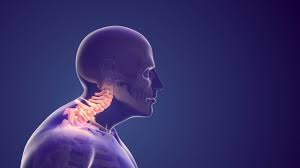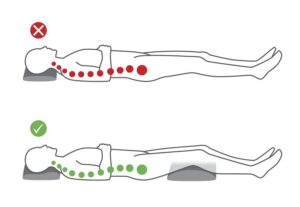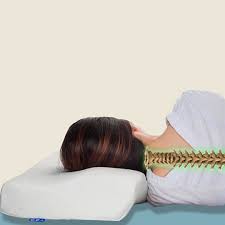

To learn more on how I fixed my crane neck posture while I slept at night, you’ve got to read my article carefully.
While (I do agree that) it may sound too good to be true but even you can correct your forward head posture by merely adopting “good sleeping practices”.
So, is really possible to turn into a “human being” from a “bird”?
Well, that was just a joke. Actually, forward head is also commonly known as crane neck posture.
In reality, it is definitely possible to correct and fix your crane neck posture literally by learning how to sleep “right” at “night”.
To know more, just read on:
Contents of How I Fixed My Crane Neck Posture While I Slept at Night Article:
1) What does Crane Neck Refer to in Humans?
2) How did I Get Bad Neck Posture?
3) Is Crane Neck Posture Life Threatening?
4) How I Fixed My Crane Neck Posture by Changing the Way I Sleep?
5) FAQs on Fixing Crane Neck Posture while Sleeping
6) The Final Results after a 30 Day Trial
What does Crane Neck Refer to in Humans?
A crane neck can be described as a condition wherein the neck of the concerned individual is driven towards a certain direction. This is a purposeful act that is not considered natural.
As you may have often overheard the phrase “craning the neck”, this in turn implies straining your neck and head in a particular angle in order to view the desired object.
In human beings, a crane neck posture can be described as a deliberate act to stretch your head to achieve your aim.
These “main aims” that I can think of are:
@ working on a laptop without adjusting the screen height,
@ watching videos on your cellphones,
@ reading a book for long hours without maintaining natural neck position – probably lying down and reading a book,
@ habit formation that takes months or years to take effect (and)
@ chronic depressive tendencies that force you to look down.
Please Note: Our present day lifestyles are driven towards achieving material goals and NOT towards achieving good physical or mental health.
Hence, the reasons for developing crane neck posture are endless indeed.
How did I Get Crane Neck Posture?
My story is somewhat similar. My forward neck was a result of lifestyle choices. When I was young, the position of my neck and head was normal.
While I had a slight curve in the cervical spine, it is completely natural and necessary to have one. This natural curve of the cervical spine allows the head to rest atop the neck in a seamless manner.
In my case, my head was hunched and my neck stretched forward. I did this so as to get as close to the computer screen as possible. Sitting in front of the computer screen for hours daily made my forward neck a permanent posture.
As time passed and months turned into years, my cervical neck had completely lost its natural shape. So, regardless of what activity I performed, my head was always a few inches ahead of my cervical spine.
For example, even when I took a walk to the nearest grocery store, my head was always sliding forward. This is how I got a crane neck posture.
Is Crane Neck Posture Life Threatening?
Who said that??? No, it is not life threatening but crane neck posture does have adverse health complications.
The most common health complications related to crane neck posture that I have faced are:
@ pain in the neck area
@ stiffness of the muscles located in the upper back area.
@ pain in the upper back area. In fact, the muscles located in the upper back seem stiff and shortened.
@ In the later stages, my poor neck posture affected my oxygen intake because the muscles in front of my neck had weakened. This was because my chin was always pointing forward thereby blocking my wind pipe.
@ I was constantly facing issues with my natural body posture. I could not even complete a single activity without sliding my head forward.
@ For every inch that my head slid forward, my cervical spine was bearing an added weight of approximately 10 pounds.
@ My lung’s capability to inhale and exhale was reduced by almost 30%.
@ I became shorter by almost 1.5 inches.
@ I was told that the blood flow to my brain had also decreased owing to my bad neck posture.
@ My forward hunch made me look awful. I felt nervous and bad about my own posture. It definitely affected my mental health.
@ My digestion weakened and I often felt dizzy.
@ Finally, I felt fatigued and tired without having made any extra effort to exert myself physically.
Basically, my bad neck posture had given rise to a myriad of health complications. The aches and pains in the head, upper back and neck were nagging me the most.
I was so irritated with the aches and pains that I was ready to do anything to get rid of them.
How I Got Rid of My Crane Neck Posture by Changing the Way I Sleep?
Of all the methods that I was advised by my friends at the office, I found none to be practical. So, I decided to pay a visit to a holistic health professional.
She also happened to be a trained and certified physiotherapist as well as a sleep therapist.
What the medical representative advised was shocking indeed.
She said that if I was to learn how to fix my bad neck posture then, learning how to sleep properly was definitely my priority.
Identifying My Incorrect Way of Sleeping:
Before I even knew it, I was under the impression that I could sleep the way I wanted. Flat on the belly, feet dangling off the bed, head twisted to the side and arms sprawled in all possible weird angles.
After all, sleeping was an act of rejuvenating the body and mind. So, I let my body and mind determine how I slept.
I was wrong.
Just like you need to maintain optimal head position to avoid a forward neck, you also need to maintain optimal sleep posture.
Ironically, your current sleeping position has a lot to do with your current head and neck posture.
So, I needed to learn how to sleep properly. The forward head fix thereafter was almost overnight.
Here is how I did it:
I Got Hold of a Suitable Pillow:
The first thing that my sleep therapist pointed out was to get myself a suitable pillow.
A cervical pillow is one such suggestion. It is devised by orthopedics. This pillow is shaped to provide optimal support to my head and shoulders while I sleep.
As a cervical pillow allows me to maintain my natural neck position even while I sleep, the nerves, tissues, muscles and joints of the neck and upper back are provided with optimal rest.
Basically, a cervical pillow shall help maintain the natural curve of my cervical spine.
What all did I Look Out for while Choosing a Cervical Pillow?
@ I first checked the ergonomics. The design and make of the pillow should be ideal to offer optimal head and neck support.
@ I sought a size that seemed to fit my head and shoulders properly. I found that adult pillows have the same shape and size. Only kids have a different size.
@ I opt for memory foam based cervical pillows. These are best suited to take the natural shape of your head and neck.
@ I then ensured that the fabric used in making the pillow was safe for my skin. I prefer hypoallergenic material.
@ I also made sure that I could remove the external layer of the pillow as and when I felt the need to give it a wash. After the wash, I should also have the option of re-attaching the cover to the pillow.
@ I also looked for a fabric that felt warm in cold weather season and cool in hot weather season.
@ Finally, I sought a fabric that was sweat resistant in nature. The last thing I wanted was to sweat profusely when I slept at night.
How did the Cervical Pillow Help Me?
@ Within a few days of using the cervical pillow, I felt immense comfort on my neck and upper back area.
@ The aches and pains that usually bothered me at night reduced by at least 50%.
@ Most importantly, the memory foam allowed my cervical spine to retain its original shape.
@ After about 1 month of using the cervical pillow, I final managed to sleep for 8 hours without waking up.
I Got Hold of a Suitable Mattress:
While learning how to fix forward head posture fast, I realized that a suitable mattress is important. I learnt that old and tattered mattresses with undulating cushion, tend to harm the cervical spine.
If I was to correct the muscles in my neck and head then, I had to choose the right mattress. So, after replacing my old pillow with a new one, I got about changing the mattress.
What did I Look Out for while Choosing a Mattress to Ease My Forward Neck?
@ First and foremost, I looked for a mattress that offered medium firmness. These mattresses are known to offer optimal support to my spine and shoulders.
@ Second, I chose the material of the mattress. Instead of opting for memory foam (like I had done for the pillow), I opted for a hybrid mattress. It was a combination of memory foam and latex. It offered optimal support to my spinal column.
@ Finally, I analyzed my sleeping position. I often slept on my back or the side. So, a medium to firm mattress is ideal for my sleeping position. Very rarely did I sleep on my stomach (which is a very good sign).
How did a Hybrid Mattress Help Me?
@ First and foremost, the hybrid mattress offered immense support to my spine.
@ It was a combination of spring coils and latex. It also had memory foam. So, it helped provide comfort to my shoulders and neck muscles.
@ I also felt comfortable while sleeping on a hybrid mattress as compared to sleeping on the older one.
@ The compatibility of this mattress to maintain a balance between “heat” and “cold” is simply superb. This stopped me from sweating in heat or feeling chilled during the cold weather season.
I Learnt the Correct Body Positioning for Sleeping:
In order to fix my crane neck posture, I had to learn how to sleep correctly. For this reason, I learnt the art of aligning my body in sync with what my spinal column demanded from me.
Simply put, I changed the manner in which I slept.
Here is what all I did:
Achieving the Perfect Head and Neck Position:
First, I practiced proper head posture while standing straight. I then copied the same position when I slept. This helped my memory foam pillow to support my head and neck properly.
Here is how I achieved this position:
@ I first shrugged my shoulders. I made sure that I almost touched the tip of my ears with the help of my shoulder blades.
@ Then, I pushed both my shoulders backwards. My upper back muscles were pushed back in such a manner that I could place a coin in between my spine without dropping it.
@ I then dropped my shoulders towards my hips without losing the tautness in my spine.
@ This action pushed my chest out.
@ If you look closer to the mirror then, your profile should showcase the lobes of your ears parallel to your shoulder blades.
@ This is the correct head and neck posture. You need to maintain this posture when you sleep at night.
Please Note: I did have to practice a bit (a few days to be precise) in order to get this right.
How I Adjusted My Body while Sleeping on My Back?
I am habitual of sleeping on my back and the sides. So, I had to adjust my body to both these sleeping position in my own way.
Here is what I did when I slept on my back:
@ I used the neck wedge pillow (the cervical one that I’ve mentioned above) whenever I slept on my back. It helps ease my neck and shoulders while I sleep on my back.
@ I had purchased a triangle pillow for experimentation purposes when I slept on my back. A triangle neck wedge pillow with a 10 inch width seemed to work best for me.
@ I added a knee wedge pillow with my cervical neck pillow to provide the much needed comfort to my cervical spine and back area. This worked wonders for me.
@ The knee wedge pillow seemed to work wonders by helping me maintain optimal spine position as I slept. It took the strain off my legs and lower back.
How I Adjusted My Body while Sleeping on My Side?
I also slept on my sides. It could be both the left and the right hand side. This too is considered to be a good sleeping posture. Nonetheless, I had to make certain changes to it in order to fix my forward neck.
Here is what I did:
@ Whenever I slept on my sides, my body used to turn into a “bow”. So, if someone looks at me sleeping, he would assume that my body was shaped like a bow.
@ To ease this unnatural “curl”, I placed a large pillow in between my legs.
@ I make sure to shift the pillow as close as possible to my rib cage.
@ On the pillow that separates my legs, I place the arm that is NOT resting on the mattress. The leg NOT resting on the mattress too is placed onto the same pillow.
@ This position enables me to avoid the “curving” posture that I am used to adopting when I fall asleep.
@ Apart from stopping me from curling while asleep, the leg separating pillow also provides maximum rest/comfort/support to my cervical spine.
FAQs on Fixing Crane Neck Posture while Sleeping
Q-1: What is crane neck posture, and how can sleeping habits affect it?
A-1: Crane neck posture is characterized by an exaggerated forward projection of the head and neck, often due to poor daily habits. Sleeping improperly, such as using unsupportive pillows or sleeping positions that strain the neck, can worsen this posture over time.
Q-2: How did changing my pillow help fix my crane neck posture overnight?
A-2: Switching to a cervical contour pillow that supports the natural curve of the neck helped maintain proper alignment during sleep, reducing strain on the neck muscles and encouraging correction of the forward head position.
Q-3: Can sleeping on my back improve crane neck posture?
A-3: Yes, sleeping on your back with proper neck support helps evenly distribute weight and keeps the head aligned with the spine, preventing the forward jutting typical of crane neck posture.
Q-4: What role does nighttime muscle relaxation play in correcting crane neck posture?
A-4: Relaxing tight neck muscles through gentle stretches or applying heat before bed reduces muscle tension, allowing the cervical spine to settle into a more natural position during sleep, aiding posture correction.
Q-5: Are there specific nighttime routines that promote crane neck posture correction?
A-5: Incorporating neck strengthening exercises and mindful posture checks before bed, combined with using supportive sleep aids, reinforces proper alignment and encourages the neck to adopt a healthier position during sleep.
Q-6: How does consistent sleep posture correction impact long-term crane neck posture?
A-6: Maintaining proper neck alignment each night gradually retrains muscles and ligaments, decreasing forward projection of the head and improving overall posture over weeks to months.
As per bestforwardheadposturefix.com, “these FAQs highlight practical and effective strategies for addressing crane neck posture through improved sleep habits and nighttime care”.
The Final Results after a 30 Day Trial
I tried the new sleeping position along with the new pillows and mattress for a period of 30 days.
On the first week, everything seemed the same.
Nonetheless, during the second week, I started to feel the positive effects of sleeping right. The aches and pains in my upper back and neck area reduced considerably.
In the third week, I was able to maintain normal head posture even when I was awake. The correct neck posture that I had learnt while I slept, remained with me during the day. This helped me maintain proper head posture while I went about my daily chores.
On the fourth week, I was able to maintain a normal spine posture without the aid of the leg separator pillow. Moreover, I was able to maintain a normal 8 hour sleep at night.
The ability to sleep for 8 to 9 hours without waking up (at least 3 to 4 times) at night is a simple indicator that my bad neck posture had indeed improved for the better.
Earlier, I used to wake up at least 3 times during the night owing to my aching neck and upper back muscles.
In the end, I would highly recommend others (experiencing crane neck posture) to first learn how to sleep in the correct posture. Doing so would not only help fix your bad neck posture fast, it would also boost your overall health.
References


